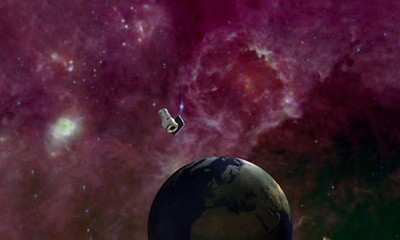Nine Month Mission May Find "Millions Of Objects"
 NASA's Wide-field Infrared Survey Explorer, or Wise, is
chilled out, sporting a sunshade and getting ready to roll. NASA's
newest spacecraft is scheduled to roll to the pad on Friday, its
last stop before launching into space to survey the entire sky in
infrared light.
NASA's Wide-field Infrared Survey Explorer, or Wise, is
chilled out, sporting a sunshade and getting ready to roll. NASA's
newest spacecraft is scheduled to roll to the pad on Friday, its
last stop before launching into space to survey the entire sky in
infrared light.
Wise is scheduled to launch no earlier than 0909 December 9 from
Vandenberg Air Force Base in California. It will circle Earth over
the poles, scanning the entire sky one-and-a-half times in nine
months. The mission will uncover hidden cosmic objects, including
the coolest stars, dark asteroids and the most luminous
galaxies.
"The eyes of Wise are a vast improvement over those of past
infrared surveys," said Edward "Ned" Wright, the principal
investigator for the mission at UCLA. "We will find millions of
objects that have never been seen before."
The mission will map the entire sky at four infrared wavelengths
with sensitivity hundreds to hundreds of thousands of times greater
than its predecessors, cataloging hundreds of millions of objects.
The data will serve as navigation charts for other missions,
pointing them to the most interesting targets. NASA's Hubble and
Spitzer Space Telescopes, the European Space Agency's Herschel
Space Observatory, and NASA's upcoming Sofia and James Webb Space
Telescope will follow up on Wise finds.

"This is an exciting time for space telescopes," said Jon Morse,
NASA's Astrophysics Division director at NASA Headquarters in
Washington. "Many of the telescopes will work together, each
contributing different pieces to some of the most intriguing
puzzles in our universe."
Visible light is just one slice of the universe's
electromagnetic rainbow. Infrared light, which humans can't see,
has longer wavelengths and is good for seeing objects that are
cold, dusty or far away. In our solar system, Wise is expected to
find hundreds of thousands of cool asteroids, including hundreds
that pass relatively close to Earth's path. Wise's infrared
measurements will provide better estimates of asteroid sizes and
compositions -- important information for understanding more about
potentially hazardous impacts on Earth.
"With infrared, we can find the dark asteroids other surveys
have missed and learn about the whole population. Are they mostly
big, small, fluffy or hard?" said Peter Eisenhardt, the Wise
project scientist at NASA's Jet Propulsion Laboratory in Pasadena,
California.
Wise also will find the coolest of the "failed" stars or brown
dwarfs. Scientists speculate it is possible that a cool star lurks
right under our noses, closer to us than our nearest known star,
Proxima Centauri, which is four light-years away. If so, Wise will
easily pick up its glow. The mission also will spot dusty nests of
stars and swirling planet-forming disks, and may find the most
luminous galaxy in the universe.

NASA Wise Artist's Concept
To sense the infrared glow of stars and galaxies, the Wise
spacecraft cannot give off any detectable infrared light of its
own. This is accomplished by chilling the telescope and detectors
to ultra-cold temperatures. The coldest of Wise's detectors will
operate at below 8 Kelvin, or minus 445 Fahrenheit.
"Wise is chilled out," said William Irace, the project manager
at JPL. "We've finished freezing the hydrogen that fills two tanks
surrounding the science instrument. We're ready to explore the
universe in infrared."
 ANN FAQ: Contributing To Aero-TV
ANN FAQ: Contributing To Aero-TV Aero-News: Quote of the Day (12.10.25)
Aero-News: Quote of the Day (12.10.25) ANN's Daily Aero-Term (12.10.25): North Atlantic High Level Airspace (NAT HLA)
ANN's Daily Aero-Term (12.10.25): North Atlantic High Level Airspace (NAT HLA) Airborne 12.08.25: Samaritans Purse Hijack, FAA Med Relief, China Rocket Fail
Airborne 12.08.25: Samaritans Purse Hijack, FAA Med Relief, China Rocket Fail Airborne-Flight Training 12.04.25: Ldg Fee Danger, Av Mental Health, PC-7 MKX
Airborne-Flight Training 12.04.25: Ldg Fee Danger, Av Mental Health, PC-7 MKX





